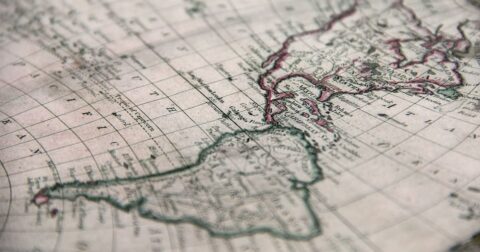News
Costco Chicken Processing Plant Keeps Failing Tests for Salmonella
Food•5 min read
Reported
The first cows arrived on the continent with Columbus on his second voyage in 1493. For many, milk is as much a drink as it is a symbol of their colonial past.


Words by Matilde Nuñez del Prado Alanes
The Americas have a long, strange history with milk. While the domestication of animals was a widespread practice in several pre-Columbian cultures, the introduction of milk to the diet on the continent began only in the 16th century as part of the process of territorial occupation and colonial domination. Today, milk production continues to occupy large amounts of land, polluting water and damaging vital ecosystems around the world, and its consumption leads to serious health problems in more than two-thirds of the world’s population.
The introduction of animals to the “New World” was one of the most effective strategies for consolidating the European colonial agenda. The first cows arrived on the continent with Columbus on his second voyage in 1493 and spread throughout the continent in a short time. The introduction and expansion of cattle to the Americas helped the conquerors to occupy territories, destroy native environments, introduce European crops, and support various extractive activities that favored the empire. As anthropologist Rosa E. Ficek writes, “Conquest worked indirectly through bodies of cattle taking up more and more space.” The native inhabitants—animals and humans—were invaded not only by the settlers but also by their animals, who helped transform the Americas’ environments to suit European ends.
The importation of animals also had an ideological background bathed in racism and a superiority complex. According to Rebecca Earle, author of The Body of the Conquistador, for Europeans, food made their bodies different from those of the natives. “Without the right foods Europeans would either die, as Columbus feared, or, equally alarmingly, they might turn into Amerindians,” she writes. In addition, the conquerors considered that their methods of agriculture, mostly based on cattle, were better than the local forms. In the eyes of the colonists, the exercise of human dominance over other creatures considered “lesser” was a demonstration of cultural superiority. Imposing their livestock system, transforming human-animal relations, and changing the feeding patterns of the natives was a way of “civilizing” them, which was one of the main objectives of colonization. Thus, food colonialism was not a consequence of the conquest, but an integral part of the imperial project.
Despite the early expansion of cows after the arrival of Europeans, milk consumption did not spread so quickly across the continent. For much of the colonial period, milk production remained at a subsistence level and was consumed mostly by the families of the hacendados, and by their workers when there was a surplus. Only towards the end of the 18th century, the growing need for labor led to concerns about the fertility, birth rate, and breastfeeding practices of female workers, and the imposition of cow’s milk as a necessary food group. The long breastfeeding period to which Indigenous and Black slaves were accustomed seemed to negatively impact fertility and reduce the amount of work for the lactating mother. In addition, the milk from these mothers was considered poor quality compared to that of European cows. For Mathilde Cohen, Professor of Law at the University of Connecticut, milk colonialism and breast-feeding colonialism are part of what she calls “animal colonialism.” “Improving or modernizing maternity meant replacing the human breast by cow’s milk,” so “lactating animals were conscripted in a colonial reproductive politics aimed at reforming maternity,” she writes.
Most colonies in the Americas achieved their independence from Europe between the 18th and 19th centuries, however, milk continued to be imposed throughout the region as a form of neo-colonialism linked to the interests of capital. As Merisa S. Thompson, Lecturer in Gender and Development at the University of Birmingham, writes, “Both the milk of humans and milk from animals is increasingly manipulated for economic means, with the latter increasingly coming under the purview of the law.” During the 20th century, the mass consumption of milk was the result of state policies, first in the United States and then in the rest of the continent. According to Vox.com, during World War I many American farmers left grain farming to concentrate on milk due to state demand for this food for soldiers. With the end of the war, the demand for milk dropped significantly, but its production didn’t cease, rather campaigns were implemented to encourage its consumption. Milk was advertised as essential for growing children and strengthening bones, it was introduced in school breakfasts, restaurants were encouraged to create high-dairy menus, and leftovers were sent to other countries as aid food.
In Latin America and the Caribbean, milk production quickly became an essential part of the desired economic development. Governments of the region not only created campaigns to promote milk consumption but also facilitated the importation of milking equipment and dairy processing infrastructure by large landowners, and invested in training and breeding programs. The United States also intervened through development-oriented credits that, according to Ficek, “encouraged fences, improved pasture grass, vaccination, sanitation, and other interventions that helped turn cattle into profit.” This meant the expansion of a standardized capitalist model that implies the importation of special grasses, antibiotics, herbicides, new breeds, and the introduction of new foods in the diets of the cows to improve their productivity. “As with other nation-state-building techniques, milk production has produced new forms of domination,” Veronica Pacini-Ketchabaw, Cristina Vintimilla, and Alex Berry, researchers on the issue in the Andean region, state.
Today, the colonial legacy of milk continues to affect the region. Although Latin America represents only 8 percent of the world’s population, it produces 11 percent of the world’s milk. Almost a quarter of the bovine cattle are used for milk production in Brazil, which has the second-largest dairy herd in the world and is the first producer of milk in the region. In other countries, the percentage can be even higher, as in Colombia, where 41 percent of the cows work for the dairy industry. In South America alone, milk production reached 64 million tonnes in 2018, and at the Latin American level, it increased by around 3.3 percent between 2020 and 2021. All this has negative consequences for the environment, ranging from the pollution of rivers, high emissions of greenhouse gases, excessive use of water, and, probably the most serious, the destruction of the Amazon.
It is estimated that between 1985 and 2018, the Amazon rainforest lost 72.4 million hectares of forest and vegetation cover, of which 70 percent is used for pasture and much of the rest for forage crops. Of course, local milk production contributes to some part of this catastrophe, but in this case, it shares the responsibility with the international dairy industry. According to a recent investigation by the Bureau, Greenpeace Unearthed, ITV News, and the Daily Mirror, “UK farms supplying milk and dairy products for Cathedral City Cheddar, Anchor butter and Cadbury chocolate are feeding their cattle soya from a controversial agribusiness accused of contributing to widespread deforestation in Brazil.” This affects not only millions of animals that are diminished by the loss of their territory, but also the entire ecosystem of South America, which depends on the Amazon, and the more than 100 Indigenous peoples who live there.
In addition to environmental devastation, dairy production and consumption in the Americas come with various health problems. According to a study published in The Lancet, approximately 68 percent of the world’s population suffers from lactose malabsorption. This means that once they pass early childhood they stop producing lactase and cannot digest milk sugars. However, despite the fact that in the United States lactase non-persistence occurs in a majority of African-, Asian-, Hispanic-, and Native-American individuals, the Dietary Guidelines for Americans recommends two to three daily servings of dairy products, which could be described as racial bias, according to a paper in this regard.
Lactose intolerance can present symptoms such as acne, bloating, cramps, or diarrhea, among others, and yet it is not the worst consequence of milk for health. Dairy consumption has been associated with an increased risk of breast, ovarian, and prostate cancers, autoimmune diseases, and Parkinson’s. According to the Physicians Committee for Responsible Medicine, saturated fat in milk and other dairy products contributes to heart disease, type 2 diabetes, and Alzheimer’s disease. In addition, studies show that the consumption of milk has higher risks of total mortality and, contrary to popular belief, bone fracture rates tend to be higher in countries that consume milk, compared to those that don’t. Despite all this, in most countries of the region, the Dietary Guidelines for Americans are taken as a reference, and programs to promote dairy consumption are carried out based on it—for example, in Bolivia, Ecuador, Paraguay, and Colombia—which proves that colonialism has transcended until today to the detriment of the population health.
As writer and activist Zane McNeill explains, the dominance exercised by nations and corporations from the Global North over previously colonized nations in the Global South, through international capitalism, is a form of neo-colonialism. And that is precisely what is currently happening with the dairy industry in the Americas. But what would happen if the entire region decided to leave the cow’s milk for the calves? Can we imagine another future?
Ecologically, a measure like this would contribute to considerably reducing the carbon footprint, the use of water and land, and the pollution of rivers. The use of antibiotics and pesticides would also be reduced. Deforestation of the Amazon rainforest would be much less, leading to the recovery of local flora and fauna, and allowing a greater capture of greenhouse gases. Population health would improve in many ways, helping to reduce the current overload of the health system and saving money that the States could invest in improving hospital care. It would also reduce the risk of zoonotic diseases associated with dairy production, such as tuberculosis, brucellosis, leptospirosis, salmonellosis and listeriosis.
Latin America and the Caribbean are full of nutritious plants that are perfect for preparing plant-based milks, such as amaranth, tarwi, quinoa, Amazonian nuts, peanuts, and potatoes, among many others. Changing animal milk for milk based on local plants would not only be an act of cultural and territorial vindication, but also a full exercise of food sovereignty. Workers from the old dairy sector could find employment in the native plant-based industry.
Above all, abandoning the colonial legacy of dairy would free millions of cows, bulls, and calves from the system of exploitation to which they are currently subjected, eliminate the suffering of mothers and babies that are prematurely separated every day, avoid painful diseases to hundreds of sentient animals and would allow them to enjoy the grass, the sun, and their loved ones. For humans, such an act of compassion would bring as a reward a healthier life, with a lower risk of invasive diseases and, probably, a longer life span.
So, what are we waiting for?